The crisis: one word but different meanings
The term crisis has been a fertile groundwork of research for a long time. This reality comes from the evidence that the country or the community in general must live a crisis to some extent. The issue of commitment of living with crisis pints out the scale of efficiency and draws practically the level of civilization and modernity between nations. The concept of civilizations clash coined earlier by Samuel P. Huntington has been widely understood differently: the clash comes from the difference and it is heightened by the level of the non acceptance and despising the other. Consequently, the discordance will be a subject of development between the western values and the rest of the world. Thus, the western nations led by the United States of America consider themselves as guardians of these values which should be applied over the world. The rejection or the denial of the idealism of these values by any sense leads to a disagreement taking a development path to get the form of a real clash at later stages (Universalism versus Imperialism). This implicit conception intends to sober the etymology of the crisis according to the pervasive feature of difference among individuals or nations. In another context, the crisis is defined through its idiosyncratic characteristic. It means that the concept should not or never be examined without knowing what is surrounding the event. Here, the environment imposes necessarily its requirements and the crisis subjects to these conditions. This view has been stated clearly by Harold Nicolson in this excerpt:”The structure of any international crisis is organic rather than artificial; it is the result of gradual growth; and however much one may seek to detach and mount the specimens of exposition, it must never be forgotten that at time they were part of the thought, feelings and action of sentient beings, exposed to all the impulses and fallibility of human nature”.
The growth as a positive dream and a target of nations holds implicitly a specific level of a crisis. Usually, the development requires changes in some or all considerations. The required transformations for building the ground of development collide with willingness of people to preserve their environment legacy. This collision takes at first the image of hostility and antagonism toward what has a bad or good reflection on what the individuals have earlier been accustomed to. This practical hostility evidence is much, for example: provocation, unbearable demands, irritation of public opinion, the denial of the self objective toward the general one considered as a cause (self demands are aggregated to take the concept of cause via the route of concession). The figure of hostility paves the way to the second phase to the epistemology of the crisis. This stage refers to environmental conviction of the crisis as an imperative and fatal consequence of the imbalance between individuals and their environment. This conviction is faded by the disastrous ad unacceptable living situation of people; and when their basic legacy is affected the crisis taking an image of an explicit or implicit confrontation would automatically appear. This change of outlook and behavior as a response to the level of the environmental progress generates another attitude of anger and fear from all which is new because it is supposed or generally believed that it holds a high price of disruption to be paid. In the midst of this trajectory (hostility, environment conviction, confrontation, and crisis), some considerations deserve to be mentioned:
- The intensity degree of each stage depends on the true cause of the crisis as well as the level of readiness and aptitude of the individuals.
- The interdependence of the trajectory stages is fostered by the intellectual background of the crisis environment.
- The network of the crisis management mechanism must take into consideration three points: individuals, environment and the level of progress.
The environment and the crises: a strong correlation should to be examined
The environment in its basic interpretations refers to all the surrounding effects of any event or situation. It, by this meaning, reveals the important role played by this component in the success or the failure of an experience. The environment has two distinguished compartments: the inner compartment and the outer one. The former denotes the social legacy and background of the individuals (the articulating mean of the crisis) whereas the outer component refers to all which serve as a tangible and material cover to the subset contained by the former meaning. The purpose in handling the issue of relationship of the environment with the intensity of the crisis stands on building a scale intends to weigh this intensity. This weighing machine exhibits three levels of correlation:
The ethic-environment correlation
Under this heading, both the legacy and the social background of the individuals are clustered. One might wonder how to figure out this correlation and how to measure its variation over time and space. The idea comes from considering ethics – the reality of the concept- as a common sense and to subject it to the variations of the environment. This subjection leads to a critical evaluation of the ethical contribution to increase or decrease the level of the crisis. The state of the art supposes that the relationship is negative between the level of ethics and the involvement of the environment in the crisis paradigm. The level of the crisis decreases gradually with the increase of the ethical considerations and the beliefs of the individuals. Consider the following model:
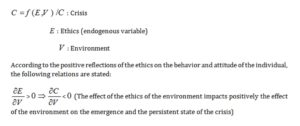
The progress-environment correlation
The interdependence between the environment and the level of well-being has been largely documented and deeply examined via the channels of economics of welfare and externalities. The development of the environment touches positively not only the persons who participated in this development but also those who do not. The level of this positive externality depends on the level of the environment progress and the interactions of the individuals living in that environment. The issue here pays attention to optimal externality coming that reduces at lowest values the negative impacts of the environment on the crises. The following model illustrates the interaction:

As the externality reached the optimal level, this leads to the situation in which the harsh effects of the environment on the crisis are:
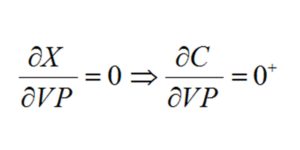
The law-environment correlation
It is largely recognized that any society is conducted by a set of regulatory tools. The purpose of the latter resides in managing the interactions between different parts of this society. The parts are naturally several: individuals, institutions, authority, religion and customs. In fact, law plays a major role to achieve the wanted harmony between all these constituting parts and to prevent any clash or disagreement between them. This disintegration of the social order into two parts: effective parts and regulatory parts is useful because it gives the term society another dimension slipping into a certain kind of institutionalization. The issue here is how the theme of the environment may be a fosterer or a damper of the society law. It is also about how these themes have functioned to pave the way for building an authoritarian consensus serving the general purpose of the society, i.e., harmony and welfare. Specifically, law is an articulator of the order and the ideology of subjection to law flows towards constructing the disciplined society. This society attempts to put up the law and order ideology. Law serves the harmony and the order creates and raises the level of welfare in one hand. At the other, law and order paradigm provides the necessary and strong shields to face the unpredictable shocks.
The applicability of the law (institutional aspect) that ensures the harmony between the different parts of the society mobilizes the positive forces (ethical and societal aspect) to realize an order paving the way to the emergence – in its first stage – of a civilization. Any destabilizing effect or denial to accept the fair share of law in the society, or in the conceptions and convictions of the individuals – the articulators and to whom the law refers- leads to conflict. The latter will be developed to take the form of a clash. The clash itself will be a background for another deficiency taking the form of a crisis. The problem here is that all the previous stages are not clearly apparent and fairly felt by the different parts of the society until the last or next to the explosion of the crisis. It is by this trajectory, that crisis seems to be an unpredictable concept in the sense that the individuals do not have the strong belief. Consequently, current destabilizing situation will lead automatically to a real crisis (belief trap).
The below diagrams show these stages:
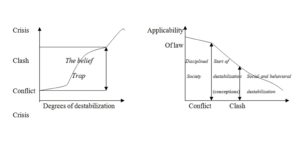
Figure 1: Crises phases
Source: the researcher
The environmental management of the crisis: a myth or a reality?
The crisis management considered both as a concept and a strategy has been a fertile groundwork for research and enquiry. The purpose of the spate of academic studies on the subject derives from the necessity to reduce the different tensions in the society. It is also considered as the ideal tool to win the confrontation that may occur between the struggling parts. In this context, Robert McNamara claimed that “there is no longer any such thing as strategy, only crisis management” (Richard Ned Lebow, p.192). This strategy entails the analysis of the crisis via two avenues: conflict and competition. It is by then looking for sobering the clash of interests (conflict) and organizing the sharing of interests among different parts (competition). The problem that should be taken into consideration is to determine the position of the surrounding environment in reducing the clash of interests and organizing their allocation.
Environment and the clash of interest
In this meaning, the environment is especially interested in figuring out the causes behind the strident quarrel of interests among different parties. The issue here remains problematic as each one of the above elements impacts the other. The more the environment intervenes –and this is usually the case- in managing the affairs of the individuals, the more the clash between them intensifies (bidirectional causality). In this stream, the concept of managing the environment comes out as essential to reduce the gap between the fundamentals (environment data) and the multiple aspirations of the inhabitants of that environment. Needless to say that the context in which we live has important and persistent upshots on the behaviors and attitudes of the persons (they respect to some extent the conditionality of their environment). This conditionality is reduced or increased according to two considerations: the intellectual level of the individuals and the progress situation of the environment. To what degree is the environment ideally beneficial to state a situation in which all the parties live in harmony is a basic point. Let’s consider the following formula:
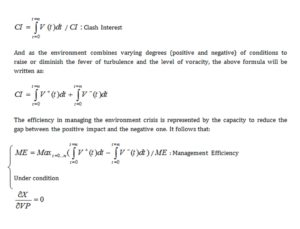
As far as the community shares perfectly the benefits between its individuals (the contingent perfect externality) and respects the conditionality of the environment (the reality of analysis), the tension between individuals reduces gradually. This is represented by the below diagram:
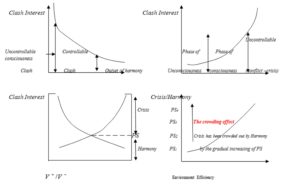
Figure 2: The Crowding Effect
Source: the researcher
The environment and the allocation of resources
The issue here is to examine the level by which the environment lessens the conflict quarrel between individuals via the best allocation of resources. For instance, the allocation of resources as both a concept and a practical strategy occupies an outstanding position in the economic philosophy. The reason behind this is that any economy must share its benefits between the inhabitants (the social consideration of the economics). Thus, the comparison between different economies is to a large extent based on their capacity to ensure the social welfare of the individuals and realize the fair share rule. The allocation mechanism to be considered as a fair economic operation must fulfill two conditions:
- The economic condition: stems from the economic justice. It means that the benefits shares are increasing as far as the effort (intellectual or physical) increases.
- The social condition: this condition means that the economy does not have the right to deprive or exclude those who did not participate in the economic activity. The essence of this idea is that these persons even if they did not contribute in the generation of wealth and the value added; they are extremely helpful in reducing such bad economic indicators such as the inflation.
The responsibility of the environment is twofold: to reduce the social disagreement and to fulfill the allocation conditions.
The allocation of resources when it interacts with the environment condition denotes an optimization problem. The latter is described as follows: how can resources be distributed in a way that prevents crisis? The allocation takes two forms: one is the horizontal form and the other is the vertical one. The former means the benefits of coexistence of persons living within specific boundaries. The more the people coexist with each other according not only to cause and effect paradigm but to the sociability target, the more the degree of the crisis will be a subject of diminution and vice versa. The latter (vertical allocation) means the institutional background of the horizontal allocation. It follows that the government for example intervenes to ensure the smooth and the organized character of the vertical sharing process.
The following model represents fully the different parts of the efficient allocation of resources:
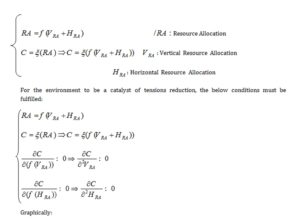
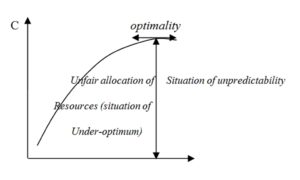
Figure 3: Allocation and Crisis
Source: The researcher
Conclusion
This paper presents a short philosophical approach about considering the environment as a barricade or a bolster of the crises. It adopts theoretical models that shed light on some basic conditions that must fulfilled when the environment is engaged in the process of managing crises. The varying degrees of the environment impacts as well as the components that build its image need a careful and cautious eye on how to segregate each component from the others and analyze it dynamically (through its impact over time). This research paves the way for further investigations taking into account the different situations and characteristics of each environment and the interaction between each situation and the surrounding crisis.
(adsbygoogle = window.adsbygoogle || []).push({});
References
- Earnest R. Mowrer. (1950) ‘Social Crises and Social Disorganization,’ American Sociological Review (15)1, 60-66.
- Ionut Purica. (2015) Final Thoughts on Crises and Adaptability,’ Non Linear Dynamics on Financial Crises, 89-94.
- Lee Smith. (2010), The Strong Horse: Power, Politics and the Clash of Arab Civilizations, New York, Anchor Books
- Michael Bruno. (1993), Crisis, Stabilization, and Economic Reform: Therapy and Consensus, New York, Oxford University Press.
- Richard, N. L. (1981), Between Peace and War: The Nature of International Crisis, Baltimore and London, The Johns Hopkins University Press.
- Samuel P. Huntington. (1996), The Clash of Civilizations and the Remaking of the World Order, SIMON & SCHUSTER, New York,
- H, Chas. C, Tony. J, John. C, Brian. R. (1978), Policing the Crisis: Mugging, The State, and Law, and Order, Macmillan Press LTD, UK
- Tzvetan Todorov. (2010), The Fear of Barbarians: beyond the Clash of Civilization, Chicago, The University of Chicago Press
- UNITED NATIONS. (2011), The Global Social Crisis, New York, Department of Economic and Social Affairs.










